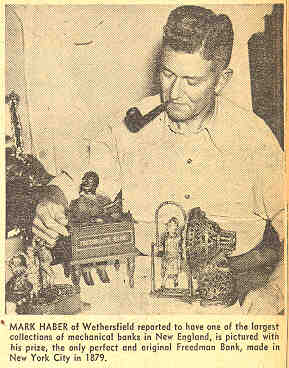Newspaper Article, By NANCY CASS, unknown source and date
Wethersfield ‘Bank Magnate’ Owns 185 of ’Em—All Sizes
 The skillful and minutely detailed workmanship of mechanical
banks fascinates Mark Haber of 12 Kenwood Rd., Wethersfield, who owns a collection of more
that 185 mechanical banks, reportedly the largest collection in New England.
The skillful and minutely detailed workmanship of mechanical
banks fascinates Mark Haber of 12 Kenwood Rd., Wethersfield, who owns a collection of more
that 185 mechanical banks, reportedly the largest collection in New England.
Being mechanically inclined and a hobbyist at heart, Mr. Haber started his collection 12 years ago and has devoted much of his leisure time to finding specimens. His prized possession is the perfect and original Freedman Bank which was made in New York City in 1879 and sold for $7.50 (pictured here). A large Negro sits on top of this bank and when a penny is inserted the Negro throws his hand in the air, spurning the pittance. Mr. Haber secured this bank from a Connecticut banker after seven years of persistent effort. He said this particular bank had been coveted by Walter P. Chrysler for his collection of banks on display at the Chrysler Building in New York City.
* * *
IN MR. HABERS COLLECTION there are banks of the circus type, winding banks and action banks. Typical of the action bank is the Bulldog Savings Bank in which the dog seizes the coin from the trainer. The Atlas Bank proves that money rules the world as a little coin dropped on Atlas spins the world on her shoulder. In another of the feature banks, a Chinaman playing poker will show his hand containing four aces in exchange for a penny.
One of the banks which has attracted a great deal of attention has a traveling dentist carrying a gas bag and extracting a tooth for a poor Negro for the fee of a coin inserted in the bank.
The children were able to buy candy at home in the days of the mechanical banks’ popularity. A penny placed in the Confectionary Bank bought the desired candy bar. Music too, was furnished by a "You Pay, I Play" musical bank, an ancestor of the present day jukebox
Sports too, are featured in the collection. There is a bank featuring a girl skipping rope and one showing Professor Pug Frog’s Great Bicycle Feat
* * *
PERHAPS THE MOST interesting of Mr. Haber’s favorite banks is one produced during Teddy Roosevelt’s days when the Anti-Monopoly trend was developing. The bank has two sides, one marked "Send the Rascals Up" and the other "Honest Labor’s Bread." On one side of the bank is the monopolist shown holding on to his monopoly. The coin is placed in the hand of the monopolist while the politicians hold the money bag. At the other end of the bank, "Honest Labor’s Bread," a working man holding a sledge hammer, is ready to strike at monopoly. If labor strikes against monopoly the worker will send the money back for bread.
The hobby of collecting mechanical banks was started in 1869 by John Hall, who introduced the Hall "Excelsior Bank." These banks were highly popular in the 1880’s when more than 200 varieties were placed on the market.
* * *
THE MOST FAMOUS manufacturer of the banks was the J. & E. Stevens Company of Cromwell. Founded in 1843 and known today for the manufacture of toy cap pistols, the company was one of the early manufacturers of these novelties which were in great demand during the 1880’s. They continued to be popular until 1918 when the price of iron and labor costs became so high that their manufacture became prohibitive.
During the days of their popularity the great majority of the novelty banks retailed for $1. Keywinders sold for $2 or $2.50. Surprisingly few of these banks are in existence today, due, Mr. Haber said, to the fact that the banks are primarily toys and that the lifetime of a toy is only about 20 years.
